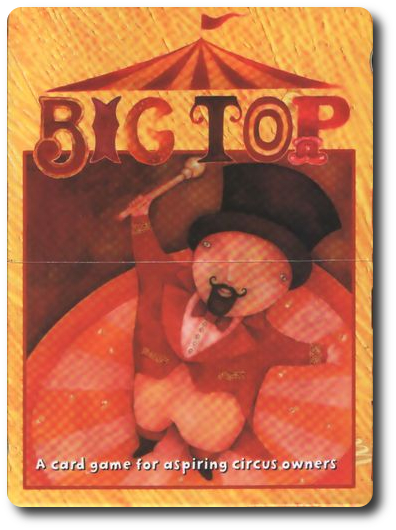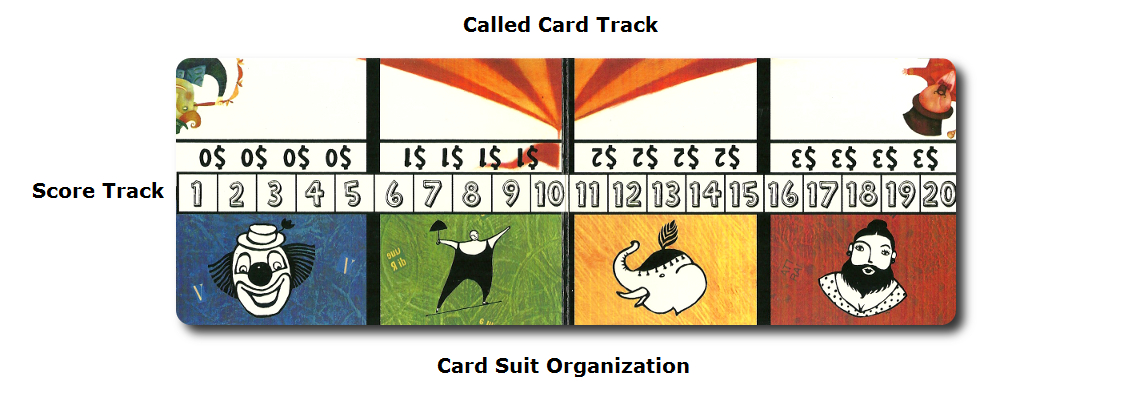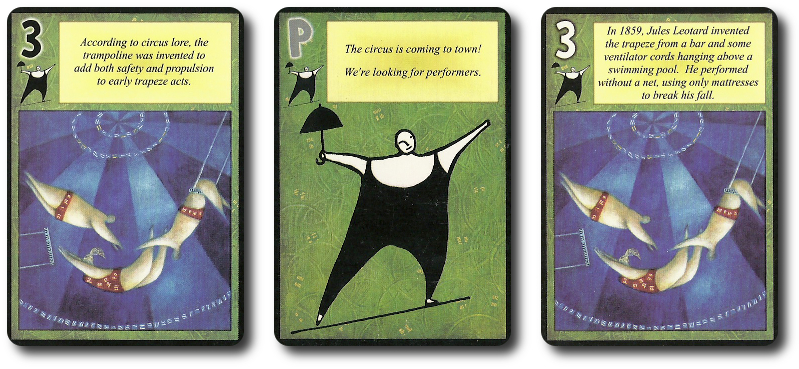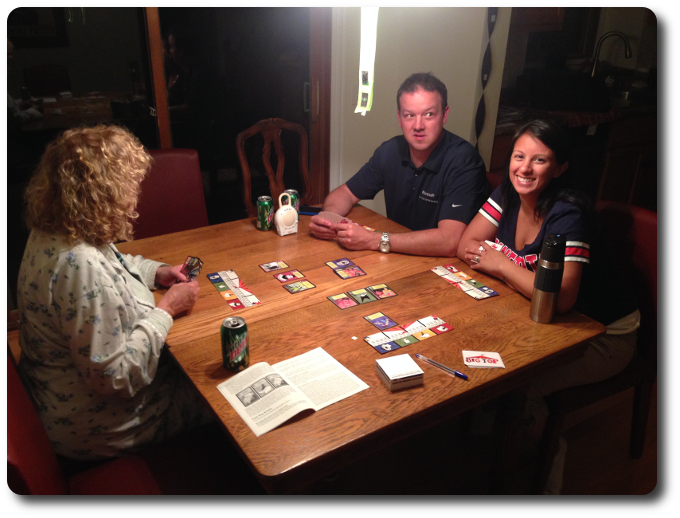
The Basics:
- For ages 7 and up (publisher suggests 8+)
- For 3 to 6 players
- Approximately 45 minutes to complete
Geek Skills:
- Counting & Math
- Logical & Critical Decision Making
- Pattern/Color Matching
- Strategy & Tactics
- Hand/Resource Management
Learning Curve:
- Child – Easy
- Adult – Easy
Theme & Narrative:
- Determine what circus acts will draw in the most crowds…and money
Endorsements:
- Gamer Geek mixed!
- Parent Geek approved!
- Child Geek mixed!
Overview
To run a successful business, you have to know what your customers want. You have a sideshow, performers, animals, and more clowns than you know what to do with. But what do your customers want to see? Should you focus on the animals or shine the spotlight on the performers? Knowing what will sell tickets is key to having the “greatest show on Earth”.
Big Top, designed by Ray Mulford and published by APE Games, is comprised of 52 Circus cards, 24 Gate Receipt tokens, 6 Scoring tokens, and 6 Organizing charts. The cards are as thick and as durable as your standard playing card. Each card is illustrated and contains a short summary of circus trivia. The Gate Receipt and Scoring tokens are small pieces of thick cardstock, which are not that durable or interesting to look at. The Organizing chart is also made thin cardboard, which is more durable than the tokens. Overall, the quality of the product is mediocre, but just fine for a card game. Not included with the game, but necessary to play, is a pen or pencil and a pad of paper to keep track of players’ scores.
Pre-Circus Set Up
To set up the game, first give each player 1 Organizing chart. These are placed in front of the players with the pictures of the four different Circus card suits facing the owning player.

Second, each player receives a set of Gate Receipt tokens and 1 Scoring token. A complete set of Gate Receipt tokens is comprised of 1 “$3”, 1 “$5”, 1 “$7”, and 1 “$10”. The Scoring token, a “+20” is placed to the left of the “1” on the Score track found on the player’s Organizing chart. The Gate Receipt tokens are set to the side for the moment. Note that it doesn’t matter if a player has Gate Receipt and Scoring tokens of different colors.
That’s it for game set up. Time to run a circus.
Under the Big Top
Big Top is played in hands and turns. The total number of hands in the game is equal to the number of players in the game. A single hand will have multiple turns. A typical hand and turn is summarized here.
Step 1: Deal Cards
Select 1 player to be the Dealer. Each player will be the Dealer once in the game. The Dealer shuffles all the Circus cards and deals them out, face-down. It doesn’t matter if 1 or more players has more cards than the other players.
Note: As the game progresses, it’s exceedingly important to shuffle the Circus cards as thoroughly as possible.
Step 2: Evaluate Hand
The Circus cards come in 4 different suits. These are “Clowns”, “Sideshows”, “Animals”, and “Performers”. Each suit has a total of 13 cards. Dark numbers 1 through 6, light numbers 1 through 6, and a “P” which represents a circus poster. The goal of each hand is to make as much money as possible by playing to the poster Circus cards. Thematically speaking, players are providing entertainment based on what the posters are advertising. Players do that by playing all the Circus cards in their hand to the poster Circus cards. Thus meeting the demand of their patrons.
Players are not doing this for free, however. They will be selling tickets. This is where the Gate Receipt tokens come into play. Each player was given the following Gate Receipt values:
- $10
- $7
- $5
- $3
These tokens are now placed, face-down, on the suit spaces found on the player’s Organizing chart. Each of the four suits are represented by their color and icon. Players should place their Gate Receipt tokens in accordance to how confident they feel about being able to play all the Circus cards of that suit before the hand ends. For example, if the player had the poster Circus card and the “1” Circus card for the “Animal” Circus cards, they should put the $10 on the Animal suit. However, if they only have the dark “6” Circus card, the player might want to consider placing a Gate Receipt of a lower value since they will not be able to play the Circus card until later in the hand.
Only after all the players have placed their Gate Receipt tokens should the hand continue to the next step.
Step 3: Play
Starting with the player to the Dealer’s left and going clockwise, each player now takes a turn. Each player, on their turn, will do the following in the order listed.
1: Decrease All Called Card Values
If Circus cards were called during a previous turn in the hand, they are now shifted to the left on the Called Card track. This decreases its value for the player’s opponents. All Circus cards on the track are shifted as far left as possible, but Circus cards never fall off or stack. If a Circus card is currently occupying the “$0” Called Card track position, it will stay there until played. It also stops other called cards from decreasing in value. Players should carefully consider what Circus cards they play to their Called Card track to avoid a “Circus card traffic jam”, as one of my Child Geeks puts it.
2: Play One Called Card
The first thing a player MUST check and do if possible is play 1 Circus card from their Called Card track. Circus cards are placed to the left or right of the Circus card suit’s poster card. Note that the suits poster Circus card MUST be played to the table before any other Circus card of that suit can be played. The different colors never go together, but it doesn’t matter which side of the poster Circus card the Circus cards are played on. When playing Circus cards, the number values must be sequential and always from the lowest value to the highest value. For example, 1, 2, 3, 4, 5, and 6. The number color must match the other number colors, too, but the number of Circus cards in each pile next to the poster Circus card do not need to match. Each pile to the left and right of the poster Circus card is independent of each other. Any Circus card that can be played MUST be played, but it’s up to the player to decide which of the Circus cards from their Called Card track they want to play to the table. This ends the player’s turn.

Example of played cards: dark to the left of the poster Circus card, light to the right
Note: Cards played from the Called Card track NEVER score points.
3: Play One Card from Hand
If the player wasn’t able to play a called card, they can now play a Circus card from their hand. Again, the player must play to the table and follow suit, number color, and number sequence. If the Circus card played matches any called card’s suit AND color positioned on their opponents’s Called Card track, the player scores points equal to the card’s position on their opponents’ Called Card track. Points are tracked by using the Scoring token, shifting in accordance to the money value the called card is currently listed. The Scoring token should be flipped over at first. When the player earns more than 20 points, the Scoring token is flipped to the “+20” side and returns to the “1” position. Multiple called cards from multiple opponents can be scored at one time. This ends the player’s turn.
Note: This is the only way a player can score points during the hand. Additional points are scored at the end of the hand.
4: Call One Card
If the player is unable to play a previously called card or play a Circus card from their hand, they must call a card. The called card is taken from the player’s hand and placed on the $3 Called Card track space, face-up. If that space is occupied by another card, the player cannot call a card. Opponents can now score off this called card and any previously played called cards. This ends the player’s turn.
Note: Poster Circus cards are never played to the Called Card track because they can always be played to the table.
5: Pass
If the player is unable to play a previously called card, play a Circus card from their hand, or call a card from their hand, then they must pass. This ends the player’s turn.
Ending the Hand and Winning the Game
The hand ends when any player plays their last card regardless of the number of turns played during the hand. Note that called cards in the Called Card track are still considered in the player’s hand and must be played to the piles to the left and right of the poster Circus cards on the table.
After a player does play their last card, the hand immediately ends and scoring takes place. All players reveal their Gate Receipt tokens they placed on their Card Suit organizer. Points are earned only for suits the players do not have in their hand or on their Called Card track. Any additional points earned on the Score track are added to scored Gate Receipt tokens and recorded as the player’s score for the hand.
A new hand now begins. All the cards are collected and the player to the previous Dealer’s left is the new Dealer who shuffles the cards. Players reevaluate their Gate Receipt tokens and place them according to their confidence level of playing cards to the table.
Every player will have a chance to be the Dealer once. When the last player to take a turn as the Dealer starts the hand, the game concludes when the last card is played for that hand. Any points earned in the final hand are added to the scores from the previous hands. The player with the highest score wins the game.
To learn more about Big Top, visit the game’s website.
Prediction
In general, Card games do fairly well with the Child and Parent Geek groups. Card games tend to be hit or miss with the Gamer Geek crowd, especially if there is no real theme to speak of and the game play is repetitive with little depth or strategy. Big Top, based only the reading of the rules, would appear to be a game the Child Geeks will enjoy, but only to a point. The pre-planning portion with the Gate Receipt token placement is going to make some of our younger players happy and some much less so. However, this type of game play will be warmly welcomed by the Parent and the Gamer Geeks. The rest of the game is pretty straight forward, with each player taking turns playing cards from their hand. As such, I predict the majority of our players will enjoy the game, with the slight chance that the Gamer Geeks and Child Geeks will return a mixed vote of approval.
Teaching Big Top is best done by going through a pre-hand set up and a player’s first turn. This demonstrates how the cards are dealt, organized, and used to determine initial Gate Receipt token placements. After that, demonstrate how players earn additional points by playing Circus cards from their hand to the table. Note that the Circus cards have text on them, but it’s not necessary to read it to play Big Top. Interesting circus trivia is provided, but being able to read it does not provide a player an advantage. Simple math is require to count scores, but this can be done by an older player if a younger player needs assistance.
And so, after teaching Big Top to my two oldest Child Geeks, I asked them their thoughts on the game so far.
“The game sounds OK, but the game parts are kind of ugly.” ~ Liam (age 9)
“OH, NO! CLOWNS!” ~ Nyhus (age 7)
The game components, other than the Circus cards, are not top-notch. I’m betting that most of our players will take note and comment on the component quality. As far as clowns go, it’s correct and proper to be afraid of them. They are creepy. Let’s play Big Top and see if it’s the greatest game on Earth of just a forgettable sideshow.
Final Word
All the Child Geeks who played understood how to play the cards to the table, but struggled with selecting the best Circus cards to play to their Called Card track. For example, a number of Child Geeks dropped their “6’s” and “5’s” to the Called Card track which lead to the Circus cards occupying the track for longer than what was necessary. The trick to the Called Card track is to (1) only play to it when it’s necessary and (2) play a Circus card to it you can play as soon as possible. The longer a Circus card stays on the track, the greater the odds of it giving points to an opponent. Only our oldest of Child Geeks understood this early on with the younger Child Geeks never really getting it. According to one Child Geek, “I like this game, but I don’t understand what it has to do with the circus.” Yes, the theme of the game is stuck on like so much wallpaper. The theme didn’t hurt the game play, but it certainly didn’t improve it either. According to another Child Geek, “The hardest thing about this game is guessing how quickly you will be able to play cards.” And therein is the heart of the game. Properly estimating the odds of how quickly you will be able to play out your entire hand is the most important aspect of the game. When all the games were done and the circus left town, the Child Geeks returned a mixed approval rating. Some liked it and some didn’t. None of the Child Geeks hated the game, however.
The Parent Geeks very much enjoyed Big Top. They found the game to be “challenging” and “engaging”, to snag a few keywords. Most importantly, the game is casual but provides enough depth to make each hand a worthwhile experience to focus in on. According to one Parent Geek, “I like this game. I’m going to have to buy it.” Another Parent Geek said, “I really like how you have to determine your odds of getting rid of a particular suit and then place the appropriate amount of points. That is pretty challenging at first and becomes entertaining later on. Especially if you are winning.” Oddly enough, none of the Parent Geeks mentioned the circus theme. It was either not important or not prevalent enough to warrant a comment. What was commented on was the game component quality. None of the Parent Geeks liked the tokens, for example. The component quality didn’t stop them from enjoying the game, however, and all the Parent Geeks voted to approve Big Top.

Enjoying a quiet evening with the Parent Geeks and Big Top
The Gamer Geeks were as mixed as the Child Geeks. Some of the gaming elitists found the game to be entertaining and engaging, while others found the game to be repetitive with very little depth. According to a Gamer Geek who enjoyed Big Top, “This is a quick game that requires its players to think ahead and play smart. I really enjoyed it.” Another Gamer Geek who enjoyed it said, “There is a lot of strategy to this game and you have to out-think and out play your opponents. Each hand is different and you have to constantly rethink about what card to play next. Excellent stuff.” Not all Gamer Geeks agreed, of course. One of the Gamer Geeks who didn’t enjoy the game said, “The game is alright if you like random fillers, but it plays too long to be worthwhile.” Another Gamer Geek said, “I find this to be a very boring game.” When all the votes were in, the Gamer Geeks gave Big Top a mixed rating.
Big Top is a re-themed version of the classic card game Fan Tan. This is not the first time APE Games has re-themed an older Card game to give it new life at the gaming table. Anathema, for example, is a re-themed version of Casino. There is a bit more going on than just a re-theme, of course, but it’s worth noting that the game in the box is based on a game that has been played by families for years. It’s pretty neat to see an old game get a new coat of paint and a second chance to entertain families and friends.
Big Top is not going to be a game I will bring to game nights with my Gamer Geek groups. Like the Gamer Geeks I played Big Top with, I found the game to be enjoyable, but not incredible. I liken it to eating a warm bowl of Ramen noodles. It’s not great, but it’s not horrible either. Which is to say, I would play it if asked without groaning about it, but not enthusiastically. But I will be keeping this game and making it part of my permanent collection. It’s perfect for Parent Geeks and non-gamers. It’s also a great game to bring out and play with the Child Geeks, despite some of them disliking the Gate Receipt placement. There is enough strategy and tactics in the game to make each play session interesting, but not overly rememberable. That’s perfect for light game plays and casual get-together events when you want to play a game to be social, but not make the game the center of attention.
If you enjoy Card games, are looking for one that has a circus theme, is light enough to play in an hour, and is easy to teach, take a look at Big Top.
This game was given to Father Geek as a review copy. Father Geek was not paid, bribed, wined, dined, or threatened in vain hopes of influencing this review. Such is the statuesque and legendary integrity of Father Geek.




Pingback: In Review: Father Geek’s Monthly Newsletter (July 2014) - Father Geek